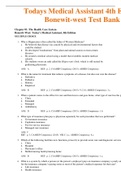Exam (elaborations)
Complete Test Bank Todays Medical Assistant 4th Edition Bonewit-west Questions & Answers with rationales (Chapter 1-50)
- Course
- Institution
- Book
Todays Medical Assistant 4th Edition Bonewit-west Test Bank Complete Test Bank Todays Medical Assistant 4th Edition Bonewit-west Questions & Answers with rationales (Chapter 1-50) PDF File All Pages All Chapters Grade A+ GRADEXAM
[Show more]



